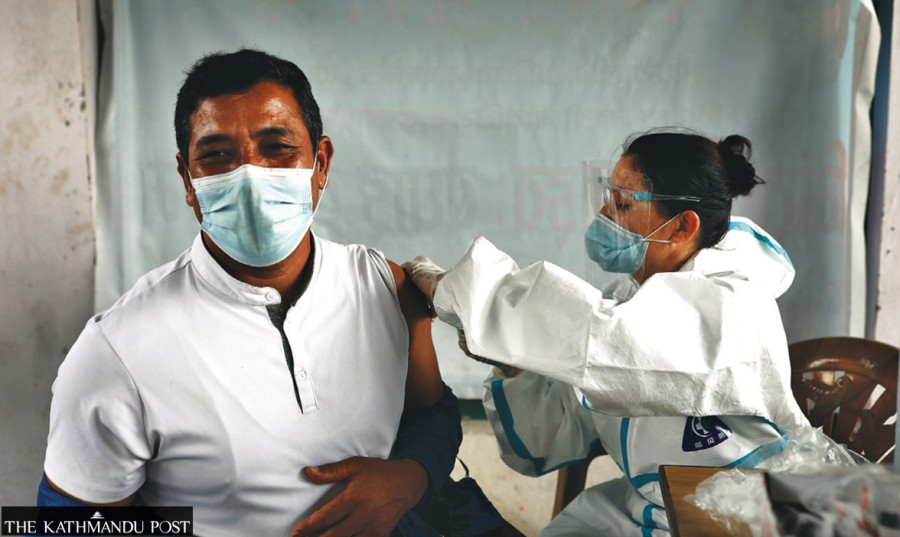Health
Health Ministry fails to meet Dashain vaccination target
The ministry had planned to raise the vaccination coverage to 33 percent by Dashain. Health experts have advised ramping up the vaccination drive while the infection numbers are low.
Arjun Poudel
The Ministry of Health and Population had planned to inoculate at least 33 percent of the total 30 million population before Dashain. But as of Monday, only 6,462,776 people or 21.54 percent of the population have been fully vaccinated.
To meet the 33 percent target, 9,900,000 people have to be fully vaccinated.
Officials at the Health Ministry, however, have retracted their previous claim and said that the target was not the 33 percent of the total population but of the population eligible for vaccine, which is people aged 15 years and above.
An official who was recently transferred from the Department of Health Services told the Post that the ministry had indeed planned to vaccinate 33 percent of the total population ahead of the Dashain festival.
“As it became apparent that it was impossible to meet the vaccination target, officials at the Health Ministry started saying that the target was to inoculate 33 percent of the people aged 15 years and older," said the official.
But even if one were to believe that the Health Ministry's plan all along was to inoculate 33 percent of the people above 15 years, the set target is still far off. To meet the target, 7,128,000 people have to be fully vaccinated; in other words, 665,224 people are still not fully vaccinated against Covid-19.
Nepal was among the first countries to start the vaccination drive against Covid-19. The country had started its vaccination programme with the 1 million doses of the Covishield (AstraZeneca) vaccine gifted by India. But the campaign faltered after India, the world's largest vaccine maker, put a ban on vaccine export to fulfil the country's own vaccine demand.
After an initial hitch, Nepal’s vaccination drive gathered momentum after doses started to arrive—procured or provided in grant assistance or through the UN-backed COVAX facility.
With the arrival of vaccines, the Health Ministry declared that 33 percent of the total population would be vaccinated before Dashain and all eligible people within mid-April next year.
“We should not doubt the government’s intention to inoculate all eligible population but the vaccination target is not going to be met if we go by the current pace,” Dr Baburam Marasini, former director at the Epidemiology and disease Control Division, told the Post. “Authorities need to accelerate the current pace of vaccination in order to meet the mid-April target.”
Nepal needs to vaccinate around 78 percent of its 30 million population—or around 25 million people, as per the government’s new plan that includes those aged between 12 and 18 years. The government earlier had planned to vaccinate only those aged 15 years and above.
Since around 4-5 million people are said to be living abroad, the government needs to vaccinate around 19-20 million people. For this, the country needs a little over 40 million doses of double-shot vaccines.
Of late, daily coronavirus cases have been declining. On Sunday, only 565 people tested positive for Covid-19 in 9,237 polymerase chain reaction tests conducted over a 24-hour period. The test positivity rate was at around 6.1 percent. It was the first time the daily test positivity rate declined to around 6 percent since the country was hit by the second wave of the pandemic in April.
And if antigen testing numbers are included, the test positivity rate declines to less than 5 percent. In 3,167 antigen tests carried out throughout the country on Sunday, only 13 people tested positive.
Public health experts say that authorities should ramp up the vaccination drive taking advantage of the current slump in coronavirus cases.
“As the number of new cases has been declining, authorities should step up the vaccination drive,” Dr Sarad Onta, a public health expert, told the Post. “Authorities concerned should utilise the opportunity and take preventive measures including increasing the vaccination pace.”
Health experts say that Covid-19 risk is still not over, as the death rate is still high. Around 10 people are dying of Covid-19 every day.
“We should be extra cautious during the festival season,” said Dr Sunita Gautam, a molecular biologist, who works as a research and development manager at Shikhar Biotech Pvt Ltd. “Dashain is here and Tihar and Chhath are also not far away. There is always a risk of Covid-19 transmission during festival gatherings. So it is important to increase the vaccination pace and inoculate all eligible people at the earliest possible.”
Officials at the Health Ministry said that they were close to achieving the target of vaccinating 33 percent of the eligible population.
“Providing vaccines for all eligible people is the government’s commitment, and the Health Ministry is working to fulfil the commitments,” Dr Samir Kumar Adhikari, joint spokesperson for the Health Ministry, told the Post.
Nepal has so far used AstraZeneca vaccine manufactured in India, Japan and Europe; Vero Cell vaccine developed by Sinopharm of China; and the single-shot Janssen vaccine made by Johnson & Johnson in the United States.
The government has already purchased 10 million doses of the Vero Cell vaccine from China. A deal has been reached with COVAX to purchase 9.9 million doses (5.9 million doses of Vero Cell and 4 million doses of Moderna vaccine) through a cost-sharing mechanism.
COVAX, the UN-backed international vaccine-sharing scheme, has committed to providing Nepal 13 million doses of Covid-19 vaccines, which will be sufficient to inoculate 20 percent of the total population.
Officials say Vero Cell vaccine doses bought through COVAX under cost-sharing mechanism are likely to be delivered starting November.
Altogether, the country has received 18,857,590 doses of Vero Cell, AstraZeneca and Johnson and Johnson vaccines.




 6.12°C Kathmandu
6.12°C Kathmandu













%20(1).jpg&w=300&height=200)
